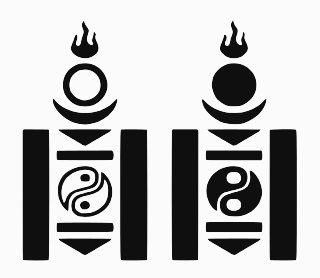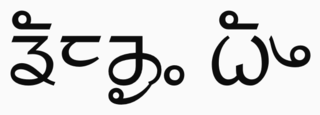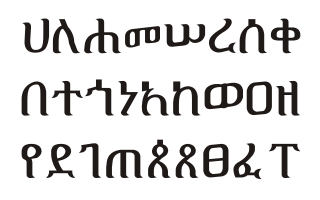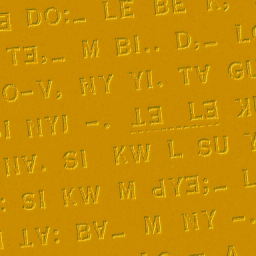
An abugida – sometimes also called alphasyllabary, neosyllabary, or pseudo-alphabet – is a segmental writing system in which consonant–vowel sequences are written as units; each unit is based on a consonant letter, and vowel notation is secondary, similar to a diacritical mark. This contrasts with a full alphabet, in which vowels have status equal to consonants, and with an abjad, in which vowel marking is absent, partial, or optional – in less formal contexts, all three types of the script may be termed "alphabets". The terms also contrast them with a syllabary, in which a single symbol denotes the combination of one consonant and one vowel.

A diacritic is a glyph added to a letter or to a basic glyph. The term derives from the Ancient Greek διακριτικός, from διακρίνω. The word diacritic is a noun, though it is sometimes used in an attributive sense, whereas diacritical is only an adjective. Some diacritics, such as the acute ⟨á⟩, grave ⟨à⟩, and circumflex ⟨â⟩, are often called accents. Diacritics may appear above or below a letter or in some other position such as within the letter or between two letters.

The Ugaritic writing system is a Cuneiform Abjad with syllabic elements used from around either 1400 BCE or 1300 BCE for Ugaritic, an extinct Northwest Semitic language, and discovered in Ugarit, Syria, in 1928. It has 30 letters. Other languages were occasionally written in the Ugaritic script in the area around Ugarit, although not elsewhere.
The African Reference Alphabet is a largely defunct continent-wide guideline for the creation of Latin alphabets for African languages. Two variants of the initial proposal were made at a 1978 UNESCO-organized conference held in Niamey, Niger. They were based on the results of several earlier conferences on the harmonization of established Latin alphabets of individual languages. The 1978 conference recommended the use of single letters for speech sounds rather than of letter sequences or of letters with diacritics. A substantial overhaul was proposed in 1982 but was rejected in a follow-up conference held in Niamey in 1984. Since then, continent-wide harmonization has been largely abandoned, because regional needs, practices and thus preferences differ greatly across Africa.
The Burmese alphabet is an abugida used for writing Burmese. It is ultimately adapted from a Brahmic script, either the Kadamba or Pallava alphabet of South India. The Burmese alphabet is also used for the liturgical languages of Pali and Sanskrit. In recent decades, other, related alphabets, such as Shan and modern Mon, have been restructured according to the standard of the Burmese alphabet

Arabic script has numerous diacritics, which include consonant pointing known as iʻjām (إِعْجَام), and supplementary diacritics known as tashkīl (تَشْكِيل). The latter include the vowel marks termed ḥarakāt.

The Soyombo script is an abugida developed by the monk and scholar Zanabazar in 1686 to write Mongolian. It can also be used to write Tibetan and Sanskrit.
Lao script or Akson Lao is the primary script used to write the Lao language and other minority languages in Laos. Its earlier form, the Tai Noi script, was also used to write the Isan language, but was replaced by the Thai script. It has 27 consonants, 7 consonantal ligatures, 33 vowels, and 4 tone marks.
Khmer script is an abugida (alphasyllabary) script used to write the Khmer language, the official language of Cambodia. It is also used to write Pali in the Buddhist liturgy of Cambodia and Thailand.

The Limbu script is used to write the Limbu language. It is a Brahmic type abugida.

Geʽez is a script used as an abugida (alphasyllabary) for several Afro-Asiatic and Nilo-Saharan languages of Ethiopia and Eritrea. It originated as an abjad and was first used to write the Geʽez language, now the liturgical language of the Ethiopian Orthodox Tewahedo Church, the Eritrean Orthodox Tewahedo Church, the Eritrean Catholic Church, the Ethiopian Catholic Church, and Haymanot Judaism of the Beta Israel Jewish community in Ethiopia. In the languages Amharic and Tigrinya, the script is often called fidäl (ፊደል), meaning "script" or "letter". Under the Unicode Standard and ISO 15924, it is defined as Ethiopic text.

Warang Citi is a writing system invented by Lako Bodra for the Ho language spoken in East India. It is used in primary and adult education and in various publications.
New Tai Lue script, also known as Xishuangbanna Dai and Simplified Tai Lue, is an abugida used to write the Tai Lü language. Developed in China in the 1950s, New Tai Lue is based on the traditional Tai Tham alphabet developed c. 1200. The government of China promoted the alphabet for use as a replacement for the older script; teaching the script was not mandatory, however, and as a result many are illiterate in New Tai Lue. In addition, communities in Burma, Laos, Thailand and Vietnam still use the Tai Tham alphabet.

Pahawh Hmong is an indigenous semi-syllabic script, invented in 1959 by Shong Lue Yang, to write two Hmong languages, Hmong Daw (Hmoob Dawb White Miao) and Hmong Njua AKA Hmong Leng (Moob Leeg Green Miao).

The Marchen script was a Brahmic abugida which was used for writing the extinct Zhangzhung language. It was derived from the Tibetan script.
U is a vowel of Indic abugidas. In modern Indic scripts, U is derived from the early "Ashoka" Brahmi letter after having gone through the Gupta letter . As an Indic vowel, U comes in two normally distinct forms: 1) as an independent letter, and 2) as a vowel sign for modifying a base consonant. Bare consonants without a modifying vowel sign have the inherent "A" vowel.
Ū is a vowel of Indic abugidas. In modern Indic scripts, Ū is derived from the early "Ashoka" Brahmi letter . As an Indic vowel, Ū comes in two normally distinct forms: 1) as an independent letter, and 2) as a vowel sign for modifying a base consonant. Bare consonants without a modifying vowel sign have the inherent "A" vowel.
E is a vowel of Indic abugidas. In modern Indic scripts, E is derived from the early "Ashoka" Brahmi letter after having gone through the Gupta letter . As an Indic vowel, E comes in two normally distinct forms: 1) as an independent letter, and 2) as a vowel sign for modifying a base consonant. Bare consonants without a modifying vowel sign have the inherent "A" vowel.

The Tai Viet script is a Brahmic script used by the Tai Dam people and various other Thai people in Vietnam and Thailand.

The Shan alphabet is a Brahmic abugida, used for writing the Shan language, which was derived from the Burmese alphabet. Due to its recent reforms, the Shan alphabet is more phonetic than other Burmese-derived alphabets.















